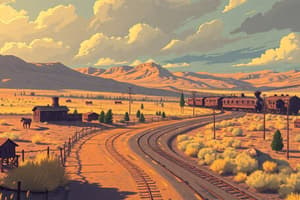Podcast
Questions and Answers
What is the primary purpose of a census?
What is the primary purpose of a census?
- To collect taxes from the population
- To determine the number of eligible voters
- To officially count the population (correct)
- To track the migration patterns of citizens
The first census of the United States in 1790 revealed a population of approximately ten million.
The first census of the United States in 1790 revealed a population of approximately ten million.
False (B)
What was the name of roads built by private companies that charged fees for their usage?
What was the name of roads built by private companies that charged fees for their usage?
- Federal Highways
- Corduroy Roads
- National Roads
- Turnpikes (correct)
Corduroy roads were primarily built in dry, desert-like environments to prevent dust storms.
Corduroy roads were primarily built in dry, desert-like environments to prevent dust storms.
Which state requested the federal government to build a road to connect it with the East after joining the Union in 1803?
Which state requested the federal government to build a road to connect it with the East after joining the Union in 1803?
What was a significant advantage of steamboats in the early 19th century?
What was a significant advantage of steamboats in the early 19th century?
Steamboats were capable of connecting the eastern and western parts of the United States effectively.
Steamboats were capable of connecting the eastern and western parts of the United States effectively.
Which of the following best describes the role of De Witt Clinton in the development of transportation infrastructure?
Which of the following best describes the role of De Witt Clinton in the development of transportation infrastructure?
The construction of a(n) _______ involved creating an artificial waterway to connect different bodies of water.
The construction of a(n) _______ involved creating an artificial waterway to connect different bodies of water.
Why was the construction of canals important during the early 19th century?
Why was the construction of canals important during the early 19th century?
Name two cities that experienced growth due to the increased use of steamboats.
Name two cities that experienced growth due to the increased use of steamboats.
Steamboats were initially favored because they offered a perfectly silent and smooth travel experience.
Steamboats were initially favored because they offered a perfectly silent and smooth travel experience.
Match the transportation innovation with its primary geographical impact:
Match the transportation innovation with its primary geographical impact:
What was the primary goal of the canal constructed in New York State?
What was the primary goal of the canal constructed in New York State?
Which of the following was a significant advantage of river travel compared to land travel during the pioneer era?
Which of the following was a significant advantage of river travel compared to land travel during the pioneer era?
The canal in New York connected Albany on the Hudson River with _______ on Lake Erie.
The canal in New York connected Albany on the Hudson River with _______ on Lake Erie.
Traveling upstream by barge against the current was generally a quick and easy task during the time of river travel.
Traveling upstream by barge against the current was generally a quick and easy task during the time of river travel.
Why were the initial steam engines used on boats in the late 18th century not very effective for major rivers or open waters?
Why were the initial steam engines used on boats in the late 18th century not very effective for major rivers or open waters?
Robert Fulton's steamboat, the __________, completed the 150-mile trip from New York to Albany in just 32 hours.
Robert Fulton's steamboat, the __________, completed the 150-mile trip from New York to Albany in just 32 hours.
Besides transportation, what other purpose did Livingston envision for the steamboat he commissioned from Fulton?
Besides transportation, what other purpose did Livingston envision for the steamboat he commissioned from Fulton?
Which of the following geographic challenges significantly hindered river travel for pioneers?
Which of the following geographic challenges significantly hindered river travel for pioneers?
The Clermont offered few comforts to its passengers during its voyages.
The Clermont offered few comforts to its passengers during its voyages.
What was James Rumsey's contribution to the development of steam-powered boats?
What was James Rumsey's contribution to the development of steam-powered boats?
Before the Clermont, using only __________, the 150-mile trip from New York to Albany would have taken four days.
Before the Clermont, using only __________, the 150-mile trip from New York to Albany would have taken four days.
Match the inventor with their contribution to steamboat technology:
Match the inventor with their contribution to steamboat technology:
Flashcards
River Travel Advantage
River Travel Advantage
More comfortable than bumpy roads; could load all goods on river barges downstream.
River Travel Disadvantage
River Travel Disadvantage
Rivers mainly flowed North-South, not East-West; hard to travel upstream against the current.
James Rumsey
James Rumsey
Equipped a small boat with a steam engine on the Potomac River.
John Fitch
John Fitch
Signup and view all the flashcards
Early Steam Engine Weakness
Early Steam Engine Weakness
Signup and view all the flashcards
Robert Livingston
Robert Livingston
Signup and view all the flashcards
Livingston's Steamboat Goal
Livingston's Steamboat Goal
Signup and view all the flashcards
Robert Fulton
Robert Fulton
Signup and view all the flashcards
Clermont's Speed
Clermont's Speed
Signup and view all the flashcards
Clermont
Clermont
Signup and view all the flashcards
Steamboat Advantages
Steamboat Advantages
Signup and view all the flashcards
Steamboat Impact
Steamboat Impact
Signup and view all the flashcards
Canal
Canal
Signup and view all the flashcards
New York's Canal Plan Goal
New York's Canal Plan Goal
Signup and view all the flashcards
Steamboat Limitation
Steamboat Limitation
Signup and view all the flashcards
Steamboat Inability
Steamboat Inability
Signup and view all the flashcards
What is a canal?
What is a canal?
Signup and view all the flashcards
Erie Canal
Erie Canal
Signup and view all the flashcards
Erie Canal Connection
Erie Canal Connection
Signup and view all the flashcards
Census
Census
Signup and view all the flashcards
First US Census
First US Census
Signup and view all the flashcards
US Population Growth (1820)
US Population Growth (1820)
Signup and view all the flashcards
Turnpikes
Turnpikes
Signup and view all the flashcards
Corduroy Roads
Corduroy Roads
Signup and view all the flashcards
National Road
National Road
Signup and view all the flashcards
National Road Funding
National Road Funding
Signup and view all the flashcards
Ohio's Request (National Road)
Ohio's Request (National Road)
Signup and view all the flashcards
National Road Purpose
National Road Purpose
Signup and view all the flashcards
National Road Construction (War of 1812)
National Road Construction (War of 1812)
Signup and view all the flashcards
Study Notes
- A census is the official count of a population.
The First United States Census
- The first United States Census occurred in 1790.
- It revealed a population of nearly four million people.
- Most Americans lived east of the Appalachian Mountains, within a few hundred miles of the Atlantic coast at that time.
Population Growth
- By 1820, just 30 years after the first census, the U.S. population more than doubled to about 10 million.
- Nearly 2 million people lived west of the Appalachians.
Turnpikes
- Private companies constructed turnpikes, also known as toll roads, to improve inland travel and facilitate the shipment of goods.
- Traveler fees were used to pay for construction.
- Many roads had a base of crushed stone.
Corduroy Roads
- "Corduroy roads," consisting of logs laid side by side, were built in muddy areas.
National Road
- Congress approved funds for a National Road to the West in 1806.
- Work was halted during the War of 1812.
- The first section, from Maryland to western Virginia, opened in 1818.
- When Ohio joined the Union in 1803, the new state requested the federal government build a road connecting it to the East.
- The National Road eventually reached Ohio and continued to Vandalia, Illinois.
- Congress saw the National Road as a military necessity, but did not undertake other road-building projects.
River Travel Advantage
- River travel was more comfortable than bumpy roads and allowed pioneers to load all their goods on river barges moving downstream.
River Travel Disadvantage
- Most major rivers flowed in a north-south direction instead of east to west, where most people were headed.
- Traveling upstream by barge against the current was difficult and slow.
Steam Engines
- James Rumsey equipped a small boat on the Potomac River with a steam engine.
- John Fitch built a steamboat that navigated the Delaware River.
- Steam engines were already used in the 1780s and 1790s to power boats in quiet waters.
- Boats did not have enough power to withstand strong currents in large rivers due to wind.
Developing Steamboats
- In 1802, Robert Livingston hired Robert Fulton to develop a steamboat with a powerful engine to travel the Hudson River from New York City to Albany.
- Livingston wanted the steamboat to carry cargo and passengers.
Clermont
- Driven by a newly designed engine, the Clermont completed the 150-mile trip from New York to Albany in 32 hours.
- Using only sails, the trip would have taken four days.
- Passengers on the Clermont could sit or stroll on deck, and relax in sleeping compartments below deck.
- The engine was noisy but provided a smooth ride.
Steamboat Advantages
- Steamboats improved the transport of goods and passengers along major inland rivers.
- Shipping became cheaper and faster.
- Steamboats ushered in a new age in river travel and contributed to the growth of river cities like Cincinnati and St. Louis.
Canals
- De Witt Clinton developed a plan to link New York City with the Great Lakes region via canal building.
Canal Construction
- An artificial waterway would be constructed across New York State.
- This would connect Albany on the Hudson River with Buffalo on Lake Erie.
Studying That Suits You
Use AI to generate personalized quizzes and flashcards to suit your learning preferences.




